25 Key drivers of employee engagement in 2025 - A complete guide

Picture this: It’s Monday morning at your company, and the usual buzz is missing. Meetings feel robotic, ideas barely spark, and the energy that once fueled your team is nowhere to be found.
Now, imagine the same Monday, but with a twist—your employees are walking in, energized, sharing weekend stories, and diving into their work with purpose. The difference? It’s not just the caffeine; it’s engagement.
Engaged employees don’t just check tasks off a list—they bring passion, creativity, and ownership to everything they do. But what drives employee engagement to that level of involvement?
In your company, it might be something as simple as recognizing wins, fostering growth opportunities, or creating a sense of belonging. Understanding these drivers is the secret to turning an ordinary workplace into an extraordinary one.
Table of contents:
- What is employee engagement?
- Why are employee engagement drivers important?
- 25 Key drivers of employee engagement in 2024
- 10 Tips to use for driving employee engagement within a remote and hybrid workforce
- What are the 4 dimensions of engagement?
- What are the elements of employee engagement?
- Employee engagement driver statistics for all the drivers
- Conclusion
- FAQs for drivers of employee engagement
Blog Highlights


What is employee engagement?

Most people associate employee engagement with employee satisfaction. However, employee engagement goes beyond just being satisfied. An engaged employee will likely take the initiative, contribute ideas, share knowledge, and stay connected with colleagues and managers. These behaviours lead to increased productivity and higher-quality output.
Employee engagement driver can be defined as “the degree to which employees participate in their work and feel they have a positive impact on achieving organizational goals.” It is a critical factor in creating successful organizations as it helps drive employee engagement and productivity in employees and keep them motivated.
Companies are looking at ways to improve employee engagement to scale their business in today's business environment. Organizations that focus on providing opportunities for employees to learn, grow and develop professionally are able to retain top talent and sustain high-performance levels using various drivers of employee engagement.



When people are financially invested, they want a return. When people are emotionally invested, they want to contribute.
Author and public speaker
Why are employee engagement drivers important?

Understanding the top drivers of employee engagement helps form strategies to improve the overall company culture that can, in turn, reduce employee turnover and increase employee engagement and satisfaction.
Hybrid and remote workplaces are becoming increasingly common as organizations strive to be more agile and responsive to the needs of their employees. As such, it is important to consider the relevance of the employee engagement drivers in these types of work environments.
There are a number of reasons why measuring different drivers of employee engagement are essential in hybrid and remote workplaces.
- These types of environments can be quite isolating for employees. Employees can easily feel disengaged from their work without regular face-to-face interaction with colleagues. This can lead to absenteeism, low productivity, and high turnover rates.
- Hybrid and remote workplaces often require employees to be highly self-motivated and self-disciplined. This can be a challenge for some individuals, who may find it difficult to stay focused and on task without the structure of a traditional office environment. Engaged employees are more likely to be motivated and productive in these kinds of situations.
- Hybrid and remote workers often have a great deal of control over their own schedules and workloads. While this can be empowering for some, it can also be overwhelming or stressful for others. Employees who are engaged with their work are more likely to have the capacity to manage their time and workload effectively, resulting in better overall performance.
- Engaged employees are better equipped to adapt to changing circumstances and setbacks. In hybrid and remote environments, where disruptions can occur more frequently, the ability to bounce back and maintain focus becomes essential. The drivers of engagement foster a resilient mindset, helping employees navigate challenges with a positive outlook.
- Employees who feel engaged tend to take ownership of their tasks and responsibilities. In hybrid and remote work arrangements, where supervision may be less constant, this sense of accountability becomes even more critical. Engaged employees are more likely to meet deadlines, fulfill commitments, and take pride in their contributions.
- Many engagement drivers encourage the use of technology for communication, collaboration, and skill development. In hybrid and remote workplaces, digital literacy is key. Engaged employees are more motivated to embrace new tools, software, and platforms, enhancing their overall tech-savviness and ability to thrive in the digital landscape.
Drivers of employee engagement give you a bigger picture of how to measure employee engagement, what to measure, and the results you gain from employee engagement in hybrid and remote workplaces.
Measuring and analyzing your drivers of employee engagement can help identify areas where employees are disengaged and identify opportunities to improve engagement. Organizations can then use this to foster a company culture of engagement that will reap numerous benefits in terms of higher productivity, satisfaction, and creativity.
What are the 4 dimensions of engagement?

When we delve into employee engagement, it becomes evident that this multifaceted concept comprises four distinct dimensions, each playing a crucial role in shaping the overall engagement landscape.
Cognitive engagement
This revolves around the intellectual connection an employee feels toward their work. It encompasses their level of concentration, focus, and absorption in tasks.
Employees who are cognitively engaged are deeply immersed in their responsibilities, displaying a genuine interest in their roles. Their minds are attuned to problem-solving, innovation, and continuous improvement, fostering a culture of intellectual vitality.
Emotional engagement
Emotional engagement pertains to the feelings an employee experience while interacting with their job, colleagues, and the organization as a whole.
It's the emotional bond that forms, leading to a sense of loyalty and commitment. When employees connect emotionally, they're more likely to exhibit enthusiasm, dedication, and a willingness to go the extra mile.
Behavioral engagement
As the name suggests, behavioral engagement centers on observable actions. It encapsulates the extent to which employees willingly invest discretionary effort into their work.
These are the employees who willingly contribute innovative ideas, collaborate proactively, and take initiative without hesitation. Their behaviors reflect a profound alignment between personal and company values, organizational goals, and the pursuit of excellence.
Social engagement
The workplace is inherently social, and this dimension underscores the importance of relationships and interactions. Socially engaged employees actively participate in team dynamics, mentorship, and knowledge sharing.
They foster a sense of community, bridging gaps between colleagues and departments. Social engagement transforms the workplace into a thriving ecosystem where communication flows seamlessly and connections flourish.
Levels of employee engagement
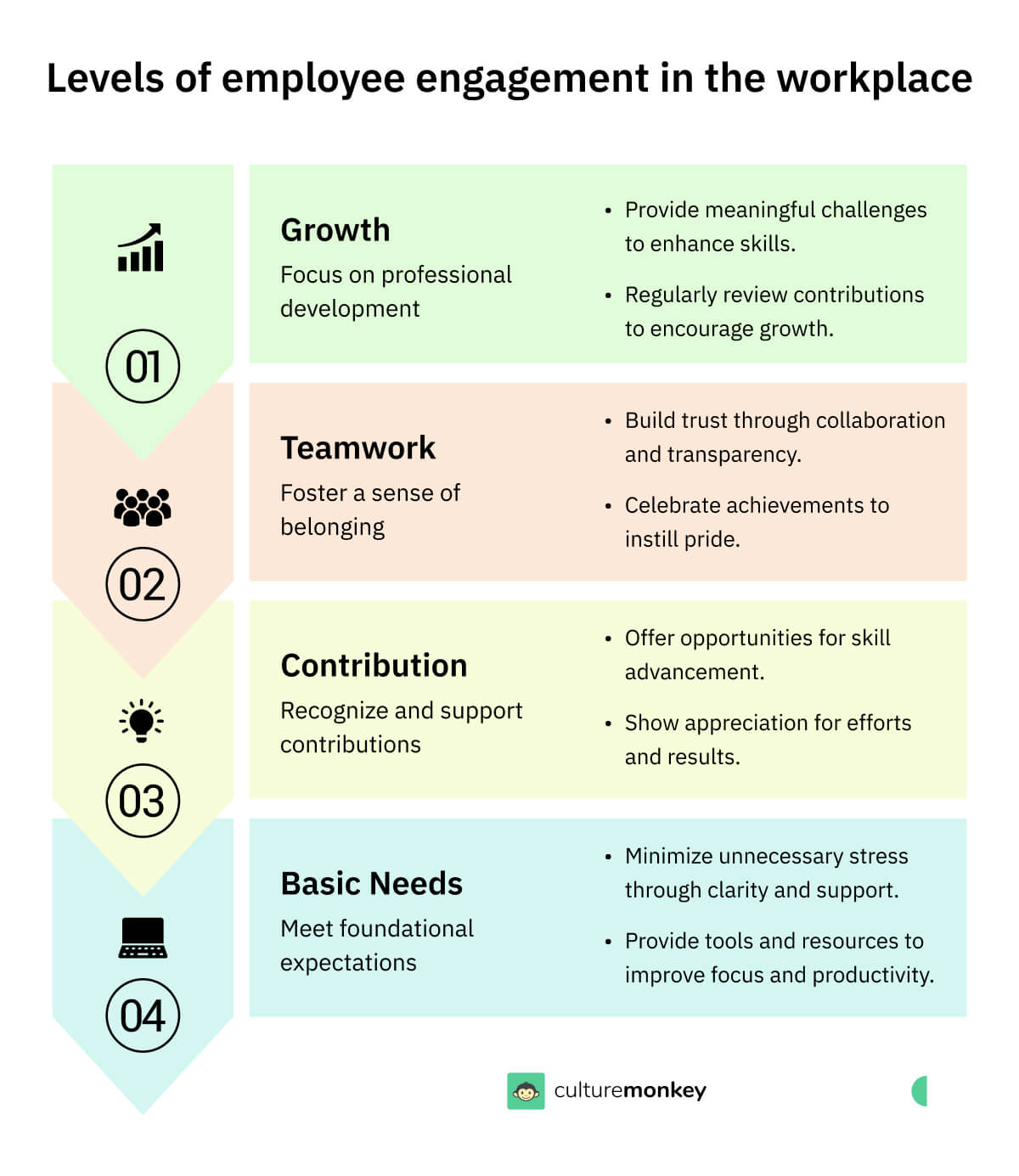
Employee engagement exists on a spectrum, with different levels reflecting varying degrees of commitment, motivation, and productivity. Understanding these levels helps organizations identify where employees stand and how to move them toward higher engagement.
- Highly engaged employees: These employees are the organization's advocates. They are deeply committed to their roles, aligned with company values, and actively seek ways to contribute beyond their job descriptions. Examples include employees who volunteer for cross-departmental projects or mentor colleagues, driving a culture of collaboration and innovation.
- Moderately engaged employees: Moderately engaged employees perform their roles adequately but lack the enthusiasm to go beyond their responsibilities. They are often waiting for clearer direction or more recognition. For example, they may complete tasks efficiently but avoid participating in brainstorming sessions or company events.
- Disengaged employees: These employees show minimal interest in their roles and are often emotionally disconnected from their work. They might avoid taking initiative and exhibit signs of low morale, such as frequent absenteeism or lack of participation in team activities. Identifying disengagement early is crucial to prevent its spread.
- Actively disengaged employees: These individuals not only lack engagement but can also negatively impact team dynamics. They may openly criticize the organization or resist change, creating a toxic environment. For instance, they may discourage others from adopting new processes or engaging in collaborative efforts.
What are the elements of employee engagement?

The following elements collectively contribute to fostering a dynamic and thriving work environment that fuels employee motivation and commitment.
Meaningful work: At the core of employee engagement lies the concept of meaningful work. When employees find purpose and significance in their roles, they are more likely to feel engaged. Meaningful work involves aligning an individual's skills and passions with their job responsibilities, enabling them to see the direct impact of their contributions on the organization's goals.
Clear expectations: Clarity in expectations is vital for engagement. When employees have a clear understanding of their roles, responsibilities, and performance standards, they can channel their efforts effectively. Ambiguity and confusion can lead to disengagement, as employees struggle to navigate their tasks without a defined path.
Supportive management: Effective leadership is a cornerstone of employee engagement. Supportive managers provide guidance, recognition, and constructive feedback. They create an environment where employees feel valued and understood, encouraging open communication and trust.
Positive work relationships: Healthy interpersonal relationships contribute significantly to engagement. A positive work environment, characterized by respect, collaboration, and camaraderie, enhances job satisfaction and loyalty. Strong employee-manager relationship fosters a sense of belonging and encourage employees to invest in their teams.
Recognition and rewards: Acknowledging and rewarding employees' efforts and accomplishments reinforce engagement. Regular recognition, both informal and formal, boosts morale and demonstrates that hard work is valued and appreciated.
Work-life balance: Striking a balance between work and personal life is essential for sustained engagement. Organizations that promote work-life balance through flexible schedules, remote work options, and wellness initiatives show that they prioritize employees' overall well-being.
Alignment with values: Engaged employees connect with an organization's values and mission. When personal values align with the company's purpose, individuals feel a sense of belonging to a larger cause, driving intrinsic motivation and dedication.
Inclusive culture: An inclusive and diverse workplace fosters engagement by embracing differences and promoting equity. When all employees feel respected and included, they are more likely to contribute their unique perspectives and talents.
Autonomy and empowerment: Providing employees with a sense of autonomy and empowerment fosters a deeper level of engagement. When individuals have the freedom to make decisions, contribute ideas, and influence outcomes, they become more invested in their work. Empowerment instills a sense of ownership and responsibility, driving proactive engagement.
Opportunities for growth: Engaged employees are committed to their professional development. Organizations that offer opportunities for learning, skill enhancement, and career advancement demonstrate a genuine interest in their employees' growth. These opportunities fuel a sense of progress and keep employees motivated to excel.
Common pitfalls in addressing engagement drivers
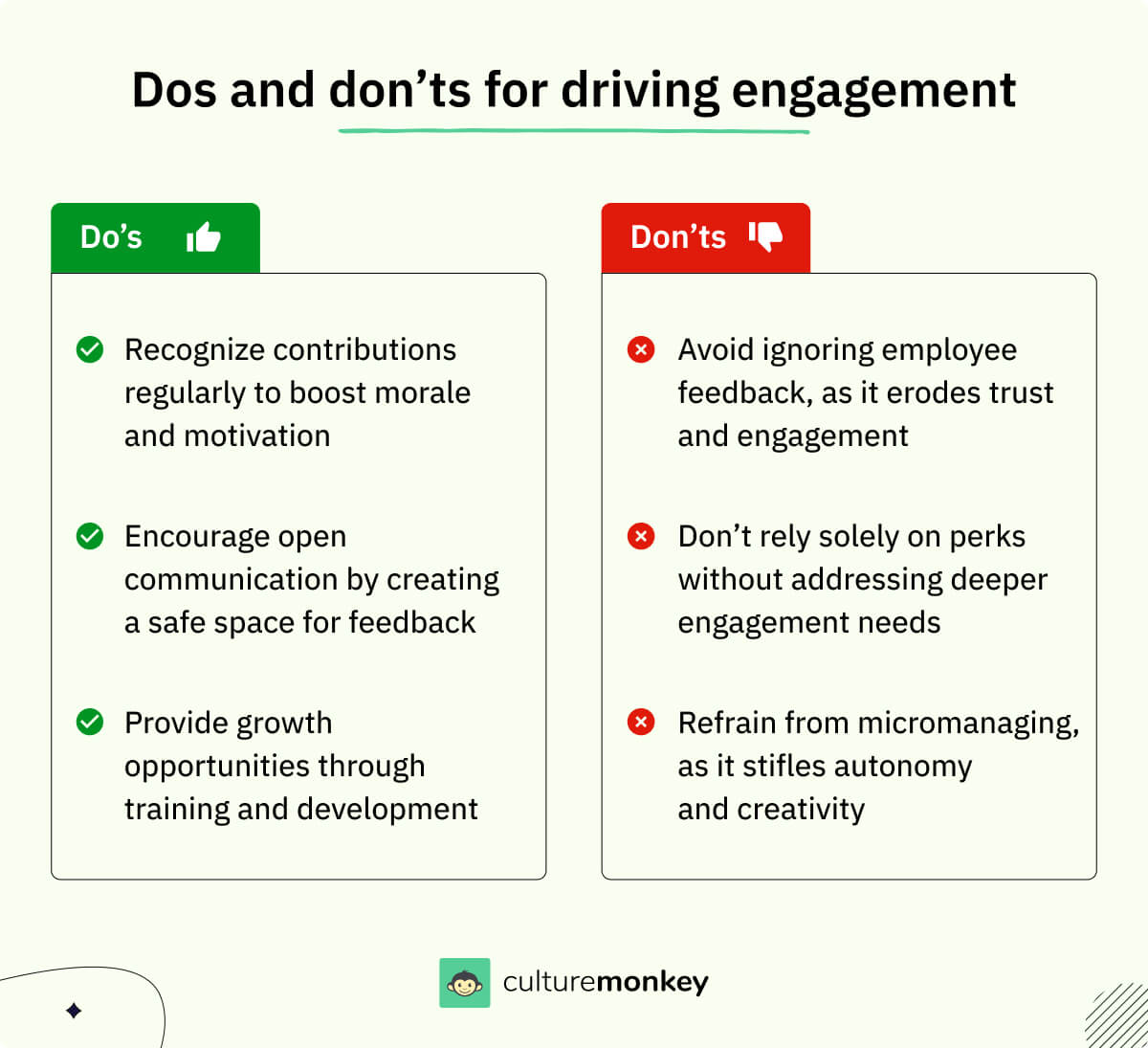
Addressing employee engagement drivers is essential for creating a thriving workplace, but even well-intentioned efforts can backfire when common mistakes are made. Avoiding these pitfalls is crucial to ensure your strategies are effective and sustainable.
- Relying solely on surveys without follow-up: Surveys are valuable for understanding engagement, but failing to act on the feedback undermines trust. Employees may feel ignored if they don’t see tangible results from their input, which can worsen disengagement rather than improve it.
- Overgeneralizing engagement strategies: What works for one department or team might not resonate with another. A one-size-fits-all approach ignores the unique needs and motivators of different employee groups, such as remote workers, frontline staff, or new hires.
- Neglecting manager involvement: Engagement initiatives often focus on employees but overlook managers, who are pivotal in influencing workplace culture. If managers aren’t aligned with or trained to support engagement strategies, even the best plans can fail.
- Overloading employees with initiatives: Introducing too many engagement programs at once can overwhelm employees, leading to initiative fatigue. This often results in reduced participation and a lack of genuine interest in any single effort.
- Focusing on perks over purpose: Offering perks like snacks or game rooms may boost morale temporarily, but they don’t address deeper needs like meaningful work, career growth, and a sense of belonging. Purpose-driven engagement is more impactful in the long term.
- Ignoring cultural and generational differences: Failing to tailor engagement strategies to accommodate diverse cultural and generational expectations can alienate employees. Addressing these nuances ensures inclusivity and relevance.
Employee engagement driver statistics for all the drivers
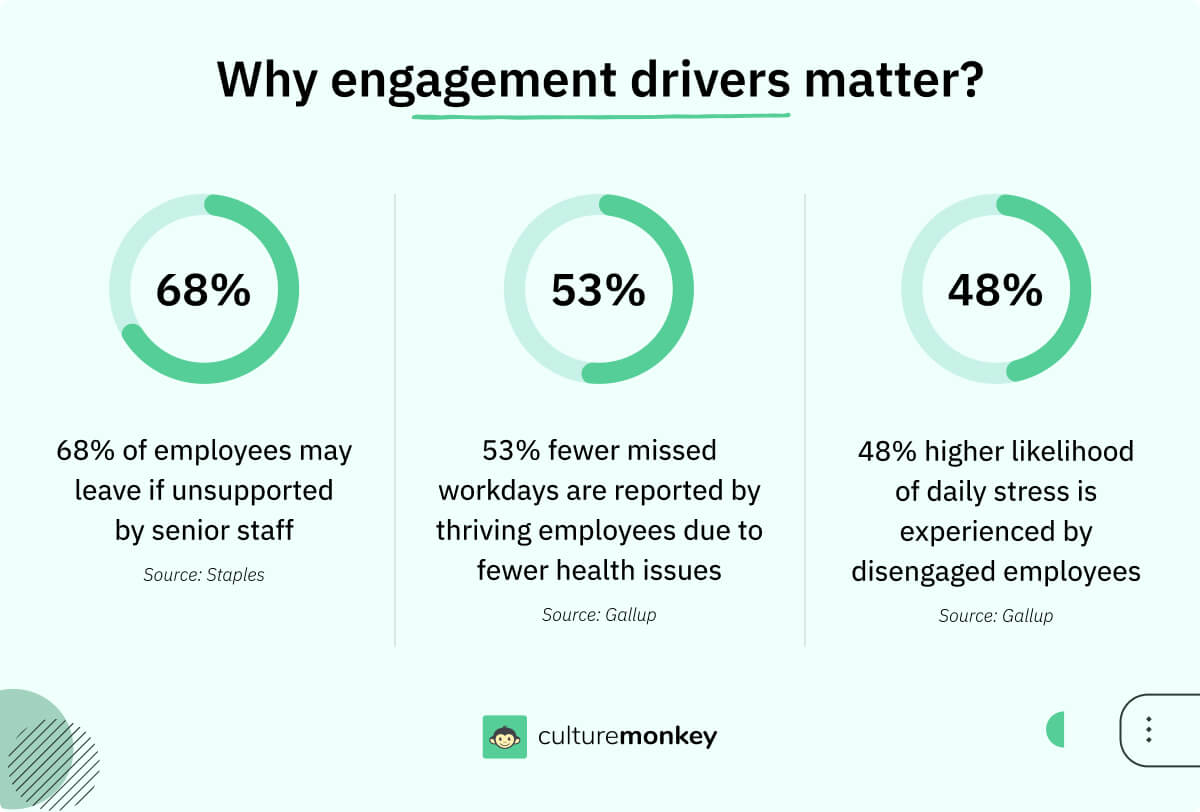
According to Forbes, poor communication erodes trust in leadership and team dynamics for more than 40% of workers.
- Glassdoor’s research reveals that feeling appreciated would lead 53% of employees to prolong their tenure within a company.
- Lorman's findings indicate that almost 59% of employees rely on self-taught skills due to a lack of workplace training.
- A study covered by Forbes involving over 7,000 employees demonstrated that those with low empowerment scored in the 24th percentile of engagement, while highly empowered individuals ranked at the 79th percentile.
- HBR reports that 59% of respondents prioritize "flexibility" over salary and other benefits.
- McKinsey's research highlights that work significantly shapes the sense of purpose for 70% of surveyed employees.
- Work-life balance proves indispensable for job satisfaction, as 86% of employees attest, according to Zipdo.
- As per Gallup, nearly 18% of current managers exhibit exceptional talent in managing others.
- Zippia reveals that 40% of employees desire enhanced inclusivity in their companies' hiring practices.
- UC Today's report underscores that over 50% of U.S. workers heavily rely on collaboration for their daily work, emphasizing its importance.
25 Key drivers of employee engagement in 2025

Employee engagement continues to be a critical factor for organizational success. Understanding and leveraging the key drivers of employee engagement can help organizations create an environment where employees feel valued, motivated, and aligned with the company's goals. Here are the top 25 drivers of employee engagement in 2025:
1) Communication
Communication is one of the key drivers of employee engagement. By sharing information about the company's goals and strategies, communicating regularly with employees, and providing feedback on performance, organizations and managers can engage employees and help them feel connected to the organization. Effective communication can also help reduce employee turnover and improve morale.
Frequent town halls, open-door policies, and interactive team meetings foster a culture of open dialogue, nurturing engagement at all levels.
“In teamwork, silence isn't golden, it's deadly." — Mark Sanbor, Author about communication in the workplace
2) Recognition
Recognizing and appreciating employees' work is a critical driver of employee engagement that influences the relationship between the employee and the employer.
Employees who believe their work is valued by the firm and advances its long-term objectives are more engaged at work. Regularly demonstrating your appreciation for employees' accomplishments is a little but meaningful gesture that helps them feel valued.
Furthermore, rewarding high-performing employees who deliver consistently and quality work can boost their morale. This reward can be in the form of a gift card, a free vacation, or as a bonus. This can also encourage and motivate other employees to do better and achieve more significant results for the organization.
Employees relish both individual recognition and team-wide celebrations, cultivating a vibrant culture of appreciation.
3) Professional development
Organizational leaders have long recognized that professional development opportunities are key drivers of employee engagement. By offering employees opportunities to learn new skills, stay current in their field, and advance their careers, organizations demonstrate a commitment to their employees' professional growth.
This commitment can pay off in the form of higher levels of employee engagement and motivation, which can, in turn, lead to better organizational performance. This driver of employee engagement also encourages employees and teams to take advantage of the available resources and opportunities.
Encouraging continuous learning through workshops, conferences, and mentorship programs empowers employees to flourish and innovate within the organization.
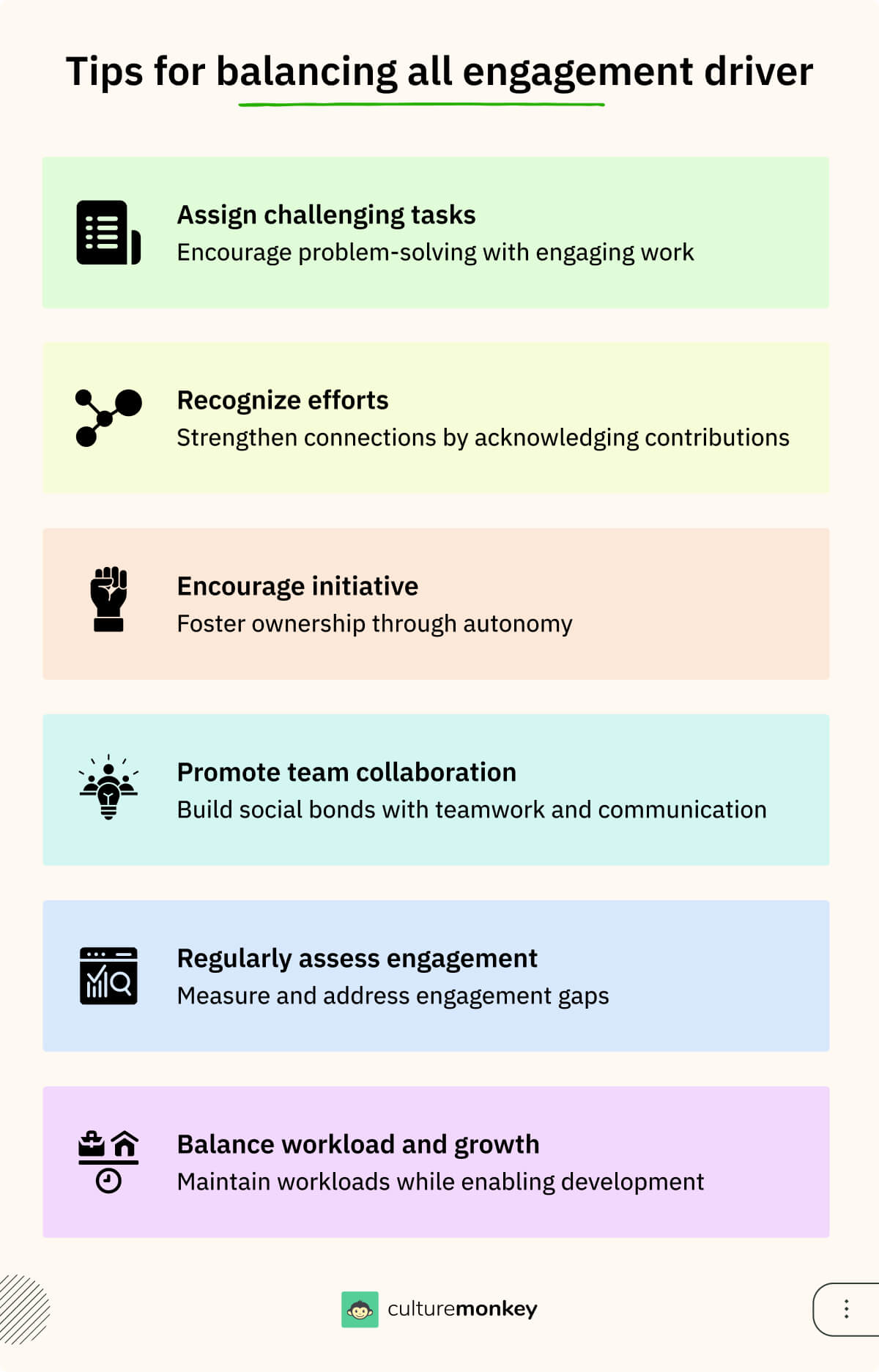
4) Empowerment
The empowerment of employees can be considered one of the most important drivers of employee engagement. Employee empowerment gives employees sense of authority and freedom to perform their work and make necessary decisions to achieve the organization's goals and objectives.
When employees feel like they have a say in what goes on in the workplace and they feel like their voices are heard, they are more likely to be engaged and productive.
Empowering employees involves entrusting them with meaningful responsibilities and fostering a culture where their contributions are valued and acted upon, inspiring ownership and commitment.
5) Autonomy
Autonomy is one of the most powerful drivers of employee engagement that helps improve employee satisfaction. When employees feel that they have a high degree of control over their work, they are more likely to be engaged and feel a sense of ownership over their projects.
This sense of control and ownership can lead to increased motivation and productivity. Employees with the control and freedom they need to perform well at their jobs increase their positive attitude toward work and the organization.
Encouraging autonomy involves defining clear goals and expectations while granting employees the flexibility to innovate and make decisions, nurturing their sense of responsibility.
6) Purpose
A sense of purpose can also help to create a more positive work environment, as employees who feel that their work is meaningful are more likely to be cooperative and supportive of their colleagues.
Employees who feel that their work is connected to a larger purpose tend to be more engaged and motivated. Measuring this driver of employee engagement will give you a clear picture of whether your leadership communication on the company mission, vision, and long-term goals are aligned with your employees.
Aligning individual roles with the broader organizational mission and highlighting the impact of each employee's contributions solidifies a shared sense of purpose and boosts engagement.
7) Work-life balance
Work-life balance is one of the most crucial drivers of employee engagement one needs to measure to improve workplace engagement. Achieving a balance between work and life outside of work is another important one of the critical drivers of employee engagement.
There are a variety of ways that organizations can support employees in achieving work-life balance. Flexible work arrangements, such as telecommuting or flexible hours, can prove to do well if the employees work from the office.
In a hybrid or remote work mode, family-friendly benefits, quarterly time-offs, and health benefits such as gym memberships or free therapy and spa sessions are some ways to avoid burnout and ensure your employee's after-work life is not interrupted by work.
“We need to do a better job of putting ourselves higher on our own ‘to do’ list.” —Michelle Obama, former First Lady about work-life balance
8) Leadership
Leader availability and integrity are two critical aspects of employee engagement. Demonstrating the commitment the leadership of the organization has toward the company’s success creates a positive impact on employees.
Furthermore, measuring this driver of employee engagement will give you an idea of whether your employees look up to their managers and people leaders for motivation and guidance. They should be dependable, reliable, and approachable by the employees so that they feel at ease when looking for support, which improves interpersonal trust.
Leadership that is approachable, empathetic, and leads by example cultivates an environment of trust, where employees feel comfortable seeking guidance and collaborating with their superiors.
9) Inclusivity
A supportive and inclusive community is one of the essential drivers of employee engagement in the post-pandemic world. Encouraging healthy differences in opinion can foster success in the workplace. How? This creates the path for a collaborative mindset amongst employees. Remote workplaces include employees of different ethnicities, backgrounds and experiences.
Recognizing and appreciating these differences is important to understand how your organization can move forward.
An inclusive and diverse community can help employees recognize their importance in the organization and how they can help achieve the goals and objectives in unity. At the same time, encourage an open and communicative environment to voice opinions and feedback. This way, you can learn about the crucial factors and take steps to improve engagement and build a better workplace.
10) Collaboration
Measuring collaboration as a driver of employee engagement strategy in this post-pandemic era is really important. As there is a strong correlation between collaboration and employee engagement. Employees sometimes need to work as a team member rather than individually for certain projects and tasks. When employees feel like they can collaborate with their colleagues, teams, and organization effortlessly, they tend to feel valued.
Collaboration can lead to increased communication, creativity, and productivity and helps build trust and respect among employees.
Encouraging cross-functional collaboration and providing platforms for idea-sharing fosters an environment where diverse perspectives unite, generating innovation and shared success.
11) Workplace relations
Positive relationships at the workplace are a good driver of employee engagement. This includes employee relations with the managers or superiors, co-workers, and the organization itself.
Engaged employees are more likely to advocate for their organization and be satisfied with their job and will become positive promoters of your organization, reducing hiring costs.
Nurturing healthy interpersonal connections involves fostering a culture of mutual respect, appreciation, and open communication, enabling employees to form strong bonds and find fulfillment in their work relationships.
12) Work environment
This driver of employee engagement can either support or hinder an employee's ability to do their job. This critical engagement driver will likely be high if the work environment is conducive to employee productivity.
However, employee engagement will suffer if the work environment is unsupportive or even hostile. Therefore, employers need to create a work environment that supports employee engagement.
A well-designed physical workspace, along with policies that prioritize comfort, safety, and collaboration, establishes the foundation for a work environment that fosters engagement and encourages employees to give their best
13) Innovation
Taking the initiative can be a great driver for employee engagement. You can create a more dynamic and engaging work environment by encouraging employees to come up with new ideas and solutions. Additionally, providing them with opportunities to contribute can help to improve job satisfaction by providing employees with opportunities to use their creativity and skills.
14) Psychological safety
The most essential driver of employee engagement that one can’t skip measuring is psychological safety at the workplace. When employees are able to be themselves and share their ideas, they are more likely to feel safe without fear of backlash. A safe environment allows employees to take risks, experiment, and learn from mistakes. This leads to a more innovative and productive workforce.
15) Positive Mental Health
Sound health does not just point to physical health. One of the most neglected and yet equally important parts of every employee’s life is their mental health. Mental health can be affected by performance pressure, job insecurity, and poor relationships with managers or co-workers. Whatever the reason, poor mental health can affect an employee’s productivity and overall performance.
Providing employees with an Employee Assistance Program (EAP), time and space for employees to relax, and a survey for self-assessment on mental health with clinical screenings or free consultations with therapists can help.
Moreover, measuring employee wellness and well-being as a driver of employee engagement will help you analyze how you can help improve employee engagement by promoting a positive mental and physical health culture within the organization.
16) Feedback loop
A robust feedback loop is the heartbeat of engaged teams. Regular, constructive feedback nourishes growth, fosters camaraderie, and fuels innovation. When employees feel heard and valued, their enthusiasm soars. This loop bridges gaps, aligning expectations and aspirations.
An engaged workforce welcomes feedback as a catalyst for improvement, driving continuous evolution and sparking a shared sense of achievement. Embracing employee feedback cultivates a culture of openness and constant learning.
17) Flexible work options
Empowerment thrives in flexibility. Offering varied work options empowers employees to tailor their schedules, enhancing work-life harmony. In hybrid or remote setups, this driver becomes a game-changer. Freedom to adapt work hours and locations boosts motivation, magnifying output quality.
Trusting employees to manage time cultivates loyalty, enriching engagement. As work boundaries blur, flexible options empower teams to excel on their terms. Flexibility isn't just a perk; it's a gateway to unleashing untapped potential.
18) Community involvement
Engagement flourishes when roots extend beyond the workplace. Encouraging community involvement empowers employees to channel their passion and purpose outward. Volunteering, charity drives, and social initiatives unite teams for a shared cause.
This driver fortifies connections, fostering a sense of belonging that transcends office walls. When employees feel part of a greater mission, enthusiasm ripples, engagement thrives, and a brighter future beckons. Contributing to the community isn't just benevolence; it's a source of inspiration that reinvigorates teams.
19) Recognition of contributions
Acknowledge and celebrate employee contributions in meaningful ways. When employees see their hard work and dedication recognized, it validates their efforts and boosts morale. This can be done through formal awards, shout-outs in meetings, or personalized notes of appreciation, creating a culture of recognition that drives engagement and loyalty.
Implementing peer-to-peer recognition programs allows colleagues to appreciate each other's contributions, fostering a supportive and collaborative work environment. Regularly highlighting exemplary behavior and achievements encourages continuous improvement and reinforces positive behaviors across the organization.
20) Clear career progression
Employees need to see a clear path to career advancement. Providing transparent career progression plans, regular career development discussions, and opportunities for promotions and lateral moves helps employees envision their future within the company. This clarity and potential for growth can significantly enhance engagement and retention.
Offering skills development workshops, mentoring programs, and cross-functional project opportunities prepares employees for future roles and demonstrates the organization's investment in their long-term success. Aligning personal career goals with organizational objectives encourages commitment and enhances overall job satisfaction.
21) Transparent leadership
Transparency from leadership fosters trust and respect. When leaders communicate openly about company goals, challenges, and changes, it demystifies the decision-making process and aligns employees with the organizational vision. This transparency can bridge the gap between employees and leadership, enhancing engagement through mutual understanding.
Soliciting feedback from employees on strategic decisions and operational changes demonstrates a commitment to inclusivity and empowers employees to contribute to the organization's success actively. Transparent communication builds a culture of accountability and collective responsibility, fostering a positive work environment where employees feel valued and informed.
22) Health and wellness programs
Promoting health and wellness is essential for sustaining employee engagement. Offering comprehensive wellness programs, mental health support, fitness initiatives, and healthy work-life integration policies can help employees maintain their physical and mental health. A healthy workforce is more productive, engaged, and capable of contributing effectively to the organization's success.
Organizing wellness challenges, providing access to nutrition counseling, and offering ergonomic assessments and workplace accommodations demonstrate the organization's commitment to employee well-being. Supporting a healthy lifestyle through flexible work arrangements and stress management workshops further enhances overall job satisfaction and reduces absenteeism.
23) Social connections
Facilitating social connections among employees can boost engagement by fostering a sense of community and belonging. Encouraging team-building activities, social events, and informal gatherings helps employees build relationships and feel more connected to their colleagues. Strong social ties can enhance job satisfaction and create a supportive work environment.
Establishing affinity groups or employee resource networks based on shared interests or diversity initiatives promotes inclusivity and strengthens interpersonal relationships. Celebrating cultural festivals, organizing charity events, and participating in community service projects together foster camaraderie and deepen employees' sense of belonging to the organization.
24) Empowering managers
Managers play a critical role in driving engagement. Empowering managers with the tools, training, and authority they need to support their teams effectively can make a significant difference. Skilled managers who provide clear direction, support, and recognition can inspire higher levels of engagement and performance from their teams.
Promoting leadership development programs for managers cultivates coaching and mentoring skills, enabling them to effectively guide their teams through challenges and opportunities. Encouraging open communication and regular one-on-one meetings builds trust and enhances manager-employee relationships, fostering a collaborative and productive work environment.
25) Environmental sustainability
Demonstrating a commitment to environmental sustainability can engage employees who value social responsibility. Initiatives such as reducing the company’s carbon footprint, promoting recycling, and supporting green projects can resonate with employees who are passionate about environmental issues. This alignment with personal values can enhance their connection to the organization.
Involving employees in sustainability initiatives through volunteer opportunities, green committees, or eco-friendly workplace practices empowers them to contribute directly to the organization's environmental goals. Recognizing and celebrating achievements in sustainability reinforces a culture of environmental stewardship and inspires collective action among employees, driving meaningful engagement and pride in their workplace.
How to drive engagement through committed coworkers
Committed coworkers play a pivotal role in fostering a culture of engagement. Their enthusiasm, collaboration, and dedication inspire peers and create a ripple effect across teams. Below are strategies to harness their influence effectively.
- Encourage peer recognition: Implement peer-to-peer recognition programs that allow coworkers to celebrate each other’s achievements. Acknowledgment from peers, such as shoutouts in team meetings or internal platforms, fosters mutual respect and motivates employees to go above and beyond.
- Promote team-based goals: Set collective goals that encourage coworkers to collaborate and succeed together. For example, quarterly team challenges with rewards not only drive productivity but also deepen camaraderie among team members.
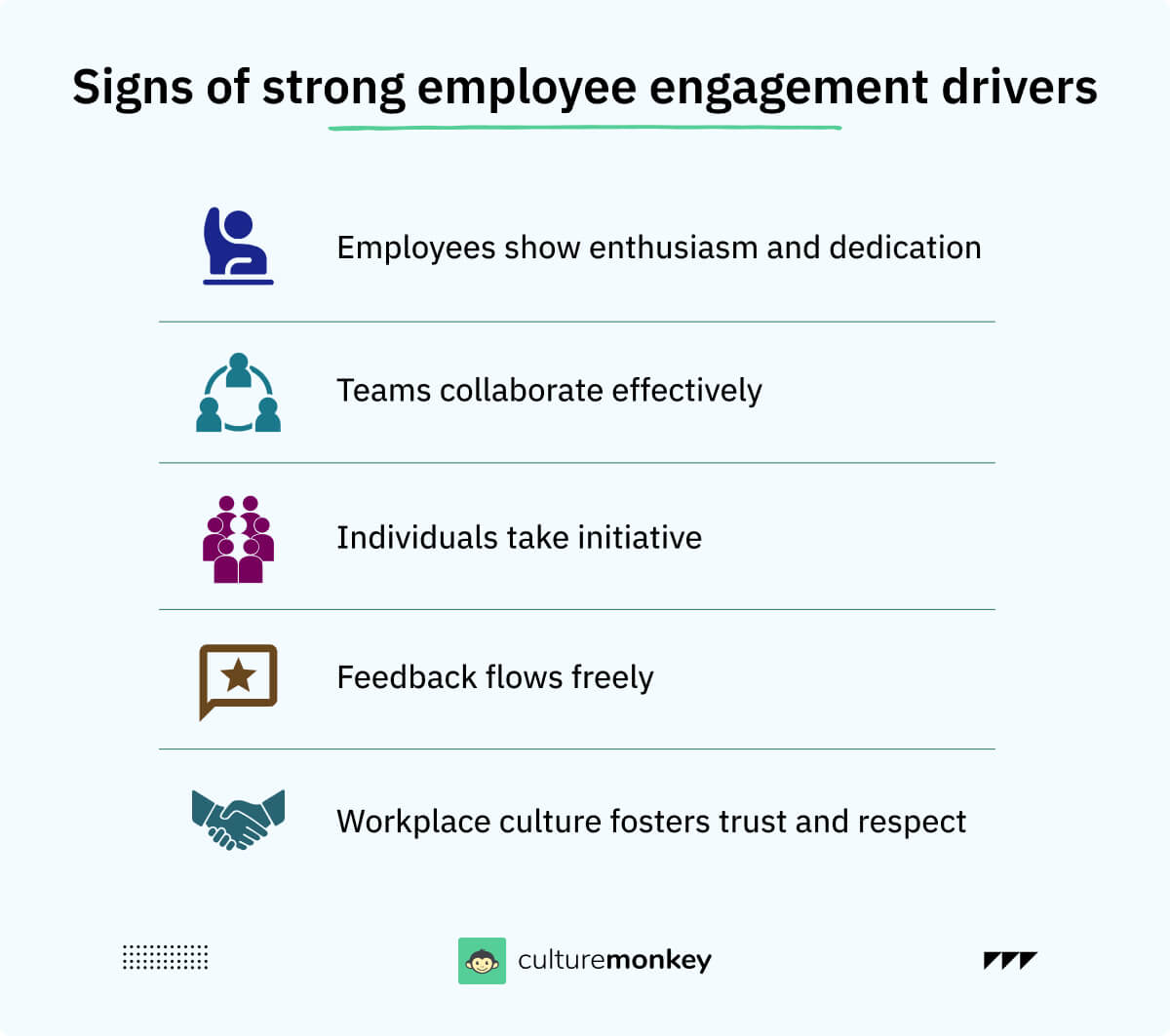
- Foster a mentorship culture: Encourage committed employees to mentor newer or less engaged colleagues. Mentorship builds confidence in mentees while giving mentors a sense of purpose, creating a win-win dynamic that strengthens team bonds.
- Highlight success stories: Showcase stories of committed coworkers who exemplify engagement and its impact. Sharing these examples during town halls or in newsletters demonstrates how individual commitment contributes to the company’s success, inspiring others to follow suit.
- Enable informal networking opportunities: Organize informal events like lunch-and-learns or interest-based clubs where employees can connect beyond work tasks. Strong personal connections between coworkers often translate into better teamwork and a more engaged workforce.
10 Tips to use for driving employee engagement within a remote and hybrid workforce

So far, we have understood several drivers of employee engagement, regardless of whether a workforce is remote or hybrid. But how can you ensure they are effective? We have come up with some tips and strategies that you can put to use to ensure maximum effectiveness from these drivers of employee engagement in your organization.
Conduct employee surveys
The most efficient way of measuring the drivers of employee engagement is through employee engagement surveys, as it provides a deeper-level understanding of each and every employee.
You can then use these surveys to develop a heatmap that displays scores based on several drivers of employee engagement in the organization.
Provide ample opportunities for growth
Engagement should never be a one-time event. To truly engage employees, organizations must create opportunities for growth and development. This can be done by measuring your drivers of employee engagement regularly, having training and development programs, mentorship opportunities, and cross-functional projects.
By providing employees with opportunities to grow, you can create a company culture of engagement driver that will inspire employees to stay with the company for the long haul.
Recognize talented, high-performing and encourage employees
Recognizing talented and high-performing employees is essential for any organization. All employees expect to be appreciated and recognized for the work they do. In order to motivate others who are unable to, it is essential to understand where they are lacking.
The drivers of employee engagement and employment scores can be used to analyze these specific areas of employee engagement. It provides valuable insights for easy tracking, which can help track engagement driver and use it to measure employee performance.
Collect feedback and implement them
Collect employee anonymous feedback regularly through employee surveys, interviews, or focus groups. You can use them to identify which drivers of employee engagement are to be worked upon. Once identifying these specific drivers, implement the required changes to improve them.
Maintain transparency
Communicate openly and frequently with your employees and be clear about how decisions are made and why certain decisions are made. Focusing on the most important drivers of employee engagement can help them feel like they are a part of the decision-making process and that their voices are heard.
Give employees authority and responsibility
Giving employees authority and responsibility is key to effectively empowering them to do their jobs. When employees feel like they have a say in what goes on and are trusted to make decisions, they are more likely to be motivated to do their best work.
Allow free flow of communication
Encourage employees to communicate openly with one another and with management. Promote an environment where employees feel comfortable sharing their ideas, concerns, and feedback. Also, encourage employees to ask questions and ensure they feel comfortable doing so.
Prioritize managerial support
Strong senior leadership is paramount in remote and hybrid environments. Empower managers to be mentors, offering guidance and support to their teams. When managers actively engage with their team members, addressing concerns and providing regular feedback, employees feel valued and motivated.
This driver fosters a culture of trust and respect, encouraging open communication and contributing to higher levels of engagement. Regular manager-employee check-ins and mentoring sessions create a sense of connection and accountability, enhancing overall engagement.
Celebrate milestones and achievements:
Recognizing accomplishments, both big and small, cultivates a culture of celebration. Remote and hybrid settings require inventive approaches to commemorate milestones. Virtual parties, personalized messages, and shout-outs during team meetings amplify this driver's impact.
Acknowledging achievements reinforces a sense of accomplishment and belonging, fueling employees' motivation and dedication. Regular celebrations demonstrate that their contributions are pivotal, nurturing a positive and engaged workforce.
Encourage cross-functional collaboration:
Breaking down silos and fostering collaboration across departments amplifies employee engagement. Encourage cross-functional projects and initiatives that leverage diverse skills and expertise.
Employees thrive when they can contribute their strengths to a broader purpose, enhancing their sense of purpose and camaraderie. This driver creates a dynamic work environment, nurturing a spirit of innovation and camaraderie. Recognize and reward successful cross-functional efforts, reinforcing the value of collaboration and encouraging continuous engagement.

Make engagement effortless
Explore simple yet powerful activities to foster engagement, trust, and a sense of belonging.
How to measure and analyze employee engagement drivers?

Measuring and analyzing employee engagement drivers is essential for creating actionable strategies that improve workplace satisfaction and productivity. A structured approach ensures that insights are both meaningful and actionable.
- Incorporate behavioral data: Go beyond surveys by analyzing behavioral data such as attendance, turnover rates, and productivity metrics. These objective indicators often reveal engagement patterns that employees may not articulate in surveys.
- Use sentiment analysis on open-ended feedback: Employ AI-driven sentiment analysis tools to decode emotions and themes in open-ended survey responses or employee comments. This technique provides deeper insights into employee sentiment beyond quantitative scores.
- Segment data for precision: Break down engagement data by demographics, departments, tenure, or roles. This segmentation helps identify specific areas needing improvement and tailors strategies for each group, ensuring no segment feels overlooked.
- Monitor trends over time: Tracking engagement drivers consistently across multiple survey cycles reveals trends and helps measure the effectiveness of implemented strategies. Use these trends to identify persistent issues and adapt your approach accordingly.
- Map drivers to business outcomes: Link engagement drivers to key performance indicators like revenue growth, customer satisfaction, or project completion rates. This analysis underscores the tangible impact of engagement on organizational success.
- Engage managers in driver assessment: Train managers to observe and report on team dynamics related to key engagement drivers. Their first-hand insights add qualitative depth to the quantitative data collected.
Conclusion
Companies need to be mindful of these fifteen critical drivers of employee engagement when it comes to driving employee engagement within a remote or hybrid workforce. Employees who feel like their work is purposeful and that they are appreciated will be more engaged than those who don't.
Similarly, employees who have a good work/life balance will be more engaged than those who feel like they're always on the clock. Lastly, effective communication is essential to keeping employees engaged; regular check-ins and open lines of communication through employee engagement surveys will ensure that everyone feels included and valued.
In the dynamic landscape of employee engagement, mastering the 18 key drivers is paramount. Empowered teams, meaningful work, and growth opportunities are the pillars of a thriving workplace. But how do you measure and enhance this engagement effectively?
CultureMonkey's employee engagement survey platform is the answer.
With its user-friendly interface, customizable surveys, and actionable insights, it empowers you to translate these drivers into action. Their data-driven approach ensures you're not just guessing but making informed decisions.
As you embark on this journey, let CultureMonkey, one of the best employee engagement survey tools, be your compass to navigate the exciting realm of engaged and motivated teams.
Summary
Employee engagement drivers are the key factors that influence how connected and motivated employees feel in their workplace. These drivers, such as leadership, recognition, growth opportunities, and communication, form the foundation of a thriving organizational culture.
By identifying and addressing these drivers, organizations can create a supportive environment that fosters loyalty, innovation, and collaboration. Prioritizing engagement drivers leads to improved productivity, enhanced job satisfaction, and stronger team cohesion, ultimately driving long-term success and organizational stability.
FAQs for drivers of employee engagement
1. What are employee engagement drivers?
Employee engagement drivers are the factors and conditions that influence the level of commitment, motivation, and emotional investment employees have in their work and the organization. These drivers encompass various elements such as communication, recognition, professional growth, leadership support, work-life balance, and a sense of purpose.
2. What are the top 5 drivers of employee engagement?
The top 5 drivers of employee engagement include meaningful work that aligns with personal values, supportive and transparent leadership, opportunities for professional development and growth, recognition and appreciation for contributions, and a positive work environment that fosters well-being and work-life balance.
3. What is the biggest driver of engagement?
A sense of purpose is often considered the biggest driver of engagement. When employees understand how their work contributes to the organization's larger mission and impact, they feel a stronger connection, motivation, and enthusiasm for their roles, resulting in increased engagement and commitment.
4. What are the 5 C's of employee engagement?
The 5 C's of employee engagement are Communication, Connection, Career, Culture, and Compensation. These elements collectively influence employee satisfaction, motivation, and commitment. Effective communication, building meaningful connections, providing career growth opportunities, fostering a positive organizational culture, and fair compensation contribute to enhanced engagement.
5. What strengthens employee engagement?
Employee engagement is strengthened through a combination of factors, including clear and transparent communication from leadership, recognition and rewards for contributions, providing opportunities for skill development and career advancement, promoting a positive work environment that prioritizes well-being, and fostering a sense of belonging and purpose within the organization. These efforts cultivate a motivated and dedicated workforce.
6. How to be more engaged at work?
To enhance engagement, prioritize tasks aligned with your strengths and interests. Seek opportunities for growth, collaborate with colleagues, and offer innovative solutions. Stay proactive, seek feedback, and maintain a positive attitude towards challenges to foster a fulfilling work experience and maximize productivity. Embrace continuous learning to adapt to evolving roles and responsibilities effectively.
7. Whose Job Is Employee Engagement?
Employee engagement is a shared responsibility between employees and organizational leadership. While employees drive their own engagement through initiative and dedication, leaders play a pivotal role in fostering a supportive culture, providing resources, and aligning organizational goals with employee aspirations. Effective communication and transparency further enhance engagement, ensuring mutual understanding and shared commitment to achieving common objectives.
8. What role does leadership play in driving employee engagement?
Leadership sets the tone for employee engagement by establishing a clear vision, fostering open communication, and promoting a culture of trust and recognition. Effective leaders provide mentorship, empower teams, and prioritize employee well-being, creating an environment where engagement flourishes through meaningful work and shared goals.
9. How can technology support employee engagement initiatives?
Technology enhances engagement by facilitating seamless communication, feedback mechanisms, and remote collaboration. Tools like employee feedback platforms, virtual team-building activities, and personalized learning platforms enable continuous development and connection, regardless of physical location. Technology-driven analytics also provide insights into employee sentiment and engagement levels, guiding targeted improvement strategies.
10. How should organizations sustain employee engagement over the long term?
Organizations sustain engagement by prioritizing ongoing communication, recognizing achievements, and investing in professional development. Cultivating a supportive work environment, promoting work-life balance, and adapting engagement strategies to evolving employee needs are crucial. Regular feedback loops, transparent leadership practices, and fostering a culture of innovation and inclusivity contribute to sustained engagement and organizational success.




